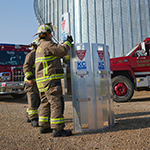Asset and equipment management
Regular inspections and maintenance of grain-handling storage assets are vital to grain bin safety.
The management of grain-handling and storage assets is vital to grain bin safety. When assets are not regularly inspected and maintained they can become dangerous hazards to anyone working with or around them.
Property assets that are typically the most important for the safe storage and handling of grain include:
- Corrugated steel grain bins
- Grain dryers
- Material-handling equipment, such as bucket elevators and conveyors
The information presented focuses on the key elements of property asset management: selection, construction, use — not abuse, inspection and maintenance, and repairs. The utilization of asset management can substantially increase reliability and life expectancy of grain storage handling assets and decrease the chance of catastrophic property loss and human injury.
Corrugated steel grain bins
Whether you're purchasing a farm bin or a large commercial grain tank, it’s important to do your research before selecting a corrugated steel grain bin. Not all bins are created equal — there are many different types based on size and expected use.
During the construction phase, it’s important to design and construct your bin for its intended use. For new bins, the main issue is inadequate foundations. Because grain bin loads have become so large, it’s important to involve a professional engineer in the design of the foundation to ensure the proper connection of the bin to the foundation. The lack of oversight before and during the construction process is one of the leading causes of future bin problems. Consider these Grain Storage Construction Guidelines to help ensure structural integrity and safety.
If you’re considering a new bin, read Grain Bin Design and Modifications to learn more about design features to help maintain grain flow and eliminate flow-stoppage incidents.
Another area of concern regarding corrugated steel grain bins is proper loading and unloading. To prevent bin damage and potential collapses, employees should be trained and retrained to load and unload bins according to the bin manufacturer’s recommendations. One good way is to require workers to thoroughly review the bin owner’s manual on proper loading and unloading recommendations and to ensure all workers fully understand their responsibilities when it comes to loading and unloading grain.
You can help preserve the structural integrity and significantly increase the life expectancy of corrugated steel grain bins and other grain-handling assets by regularly performing maintenance activities — inspection, cleaning and repair.
Use the Steel Bin Storage Annual Checklist to help document and keep track of important bin information such as owner’s manuals, inspection reports and maintenance records.
Grain dryers
One of the most important elements of maintaining the quality of stored grain is making sure the grain is dry and free flowing. The grain dryer has become an important grain quality management tool when it comes to avoiding problems with stored grain that often require dangerous bin entry.
The consistent and safe operation of a grain dryer depends on five very important factors:
Preseason preventative maintenance and repair
A grain dryer’s mechanical, electrical and gas systems must be checked, evaluated, maintained and repaired prior to the beginning of the drying season. Use the Preseason Grain Dryer Inspection and Maintenance Checklist to reduce the risk of mechanical breakdown and fire. The consequences of not doing maintenance and repair can be extremely costly.
Manufacturer operating procedures
A grain dyer is a complicated and expensive piece of equipment that requires operators to be fully trained on proper operating procedures and grain drying principles. Don’t let a simple mistake turn into a catastrophic loss. Make sure you receive a complete set of owner’s or operator’s manuals, and read and understand all the information before using your grain dryer.
Operational inspection, maintenance and cleaning
The best thing you can do with any grain dryer is to keep it clean. A clean dryer performs better and is more efficient, which can save you valuable time and money. At a minimum, your dryer should be cleaned based on the manufacturer’s specifications — more often during harsh operating conditions. Newer, computer-controlled dryers also need to be checked regularly to verify grain is flowing freely and grain moisture and temperature match what the control panel or computer is displaying.
Pre-incident fire plan
A grain dryer fire is one of the most significant risks a grain handling operation faces. Recognizing the high frequency of these types of fires coupled with the fact a grain dryer is seldom fitted with fire suppression devices, developing a pre-incident fire plan is a vitally important component to your business resiliency plan.
Postseason maintenance and repair
At the conclusion of every drying season, every grain dryer should be thoroughly cleaned, inspected and serviced per manufacturer’s recommendations. This includes all mechanical, structural, electrical and gas supply equipment. This is also a good time to identify worn or damaged parts and get them ordered for installation prior to the next drying season.
Material-handling equipment
Developing an effective maintenance program for material-handling equipment, such as bucket elevators and conveyors, creates a unique challenge for grain operators because this equipment can sit idle for long periods of time and operational demands can shift man hours away from maintenance tasks during the peak harvest season.
Ensure your maintenance program includes a protocol to exercise this equipment at regular intervals to keep parts lubricated and avoid devastating grain-bin accidents. Also take advantage of operational idle periods to implement preventive maintenance strategies such as bearing replacement at specified intervals (rather than run-to-failure type approaches which can wreak havoc when a failure occurs during peak season). Both over-lubrication and under-lubrication of bearings can shorten equipment life expectancy, so take some time to investigate the correct re-lubrication procedure for your equipment bearings.
Conclusion
The immediate benefit of asset management is increased reliability and life expectancy of your expensive grain handling and storage equipment. Utilizing the key elements of proper asset management, including employee training, can have a positive impact on employee safety and your operation’s bottom line.

 >
>

 >
>
 >
>